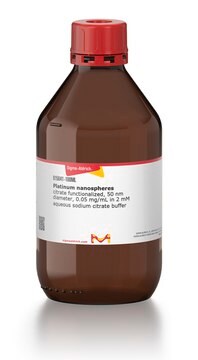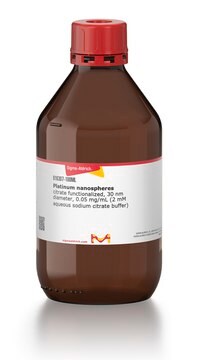916056
Platinum nanospheres
citrate functionalized, 5 nm diameter, 0.05 mg/mL (2 mM aqueous sodium citrate buffer)
Synonym(s):
Platinum nanoparticles, PtNP
About This Item
Recommended Products
form
nanospheres
Quality Level
concentration
0.05 mg/mL (2 mM aqueous sodium citrate buffer)
diameter
5 nm
functional group
citrate
storage temp.
2-8°C
InChI
1S/Pt
InChI key
BASFCYQUMIYNBI-UHFFFAOYSA-N
Looking for similar products? Visit Product Comparison Guide
Application
Storage Class Code
12 - Non Combustible Liquids
WGK
nwg
Choose from one of the most recent versions:
Certificates of Analysis (COA)
Don't see the Right Version?
If you require a particular version, you can look up a specific certificate by the Lot or Batch number.
Already Own This Product?
Find documentation for the products that you have recently purchased in the Document Library.
Articles
Dr. David Medina Cruz et. al. investigate advances in noble bimetallic nanoparticles (BMNP) to more precisely measure and monitor glucose levels in the blood. They focus on the use of enzyme-free silver and gold nanoparticles, such as Ag-Au, Ag-Pt, Ag-Pd, and Au-Pt, and how their structures contribute to biosensor detection.
Our team of scientists has experience in all areas of research including Life Science, Material Science, Chemical Synthesis, Chromatography, Analytical and many others.
Contact Technical Service




